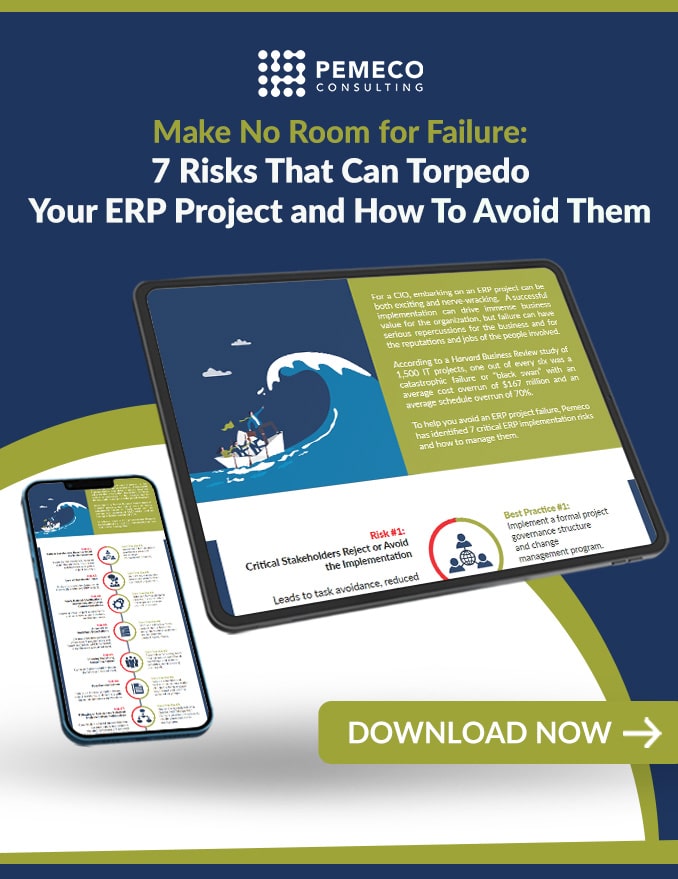When a rapidly expanding Canadian aerospace company began to outgrow their existing business processes and systems, they turned to Pemeco for help. We helped them examine key business processes, identify opportunities for greater efficiency and visibility, select the right ERP software, and roll out the new system. Once that process was complete, Pemeco worked with the client to further optimize processes. This post-implementation tuning led to a reduction in budgeting time from one month to just one week. It also led to cost savings in accounts payable and a reduction of planning, procurement, shop scheduling, and shop load efforts by 15% to 20%.
What Is ERP Optimization?
Many businesses meticulously plan their ERP implementations, often focusing heavily on the go-live date as the ultimate goal. However, some overlook the critical post-implementation phase, where true optimization and value realization occur. Once the system is live, companies typically enter a period of stabilization, lasting from one to three months. This phase is essential for ironing out initial issues and ensuring the system runs smoothly. However, without a clear strategy for post-stabilization optimization, companies may find that inefficiencies and pain points persist, which can significantly hamper their competitiveness.
ERP optimization begins after this stabilization period and is crucial for refining system performance to align with business needs. It involves taking a strategic view of your ERP system’s capabilities, including configuration and customization options, to enable continuous improvement in your organization.
ERP optimization is fine-tuning your ERP systems, the backbone for your most important business processes and home to vital information about customers, vendors, products, and many others, to increase efficiency, enhance organizational agility, reduce costs, and drive better performance.
Benefits of ERP Optimization
ERP optimization offers a range of benefits, including improved business agility, better data-driven decisions, simplified compliance, and reduced risk. It also paves the way for the adoption of new technologies and acceleration of innovation.
Let’s examine some of the ERP optimization benefits in more detail:
Reducing operational costs and other expenses
Examining various business processes often reveals opportunities to streamline and automate routine activities. For example, one Pemeco client was paying its suppliers late because their ERP system prevented them from paying suppliers until a quality check had been completed. That sometimes led to late payment penalties, preventing the company from taking advantage of prompt payment discounts. After optimizing the system, that restriction was removed, resulting in immediate cost savings.
Increasing customer satisfaction and sales
By polishing supply chain processes, companies can reduce the risk of stockouts and ensure rapid re-supply during periods of peak demand. That increases the company’s top line and improves overall competitiveness. Optimizing order-to-cash processes ensures rapid order processing, improves accuracy, and consequently increases customer satisfaction, and, ultimately, revenue.
Improving efficiency
ERP optimization improves efficiency by eliminating unwieldy workarounds, streamlining business processes, and accelerating workflows. Warehouse operations, for example, can benefit from wave picking, bin location tracking, and other features and processes supported by most ERP software. Your company can explore opportunities to use these features during an ERP optimization review.
Increasing agility
To remain competitive in a rapidly changing world, companies must respond quickly and effectively to changing market demands, price volatility, supply chain challenges, and internal dynamics. By optimizing the flow of real-time information, ERP optimization consultants can accelerate the speed of information, providing vital intelligence to executives. ERP optimization often leads to increased automation, enabling faster organizational response to change.
Enabling data-driven decisions
Advancements in business intelligence applications, including machine learning and predictive analytics, are prompting executives to invest heavily in data and decision support tools. With improved visibility to sales, inventory, and the supply chain, for example, executives can spot potential problems early and fend them off before they become serious. The drive toward data-driven decision-making is in high gear, as business leaders embrace the opportunity to inform and empower managers and even frontline employees. ERP optimization initiatives can identify the most important data flows and opportunities for improved decision-making tools.
Optimizing technology adoption
Business technology is evolving rapidly. ERP optimization helps to pave the way for innovation, enabling companies to incorporate new technologies faster. For example, Generative AI is still in its infancy but already provides real-world benefits in collaboration, communication, and automation. IoT devices, drones, mobile apps, blockchain, and other game-changing innovations are transforming processes and even entire industries. ERP assessment and optimization should include evaluating new technologies, including the opportunities and threats they pose for the organization, and then making necessary adjustments to prepare for the change.
Simplifying compliance and reducing risk
Risk and compliance have become increasingly important in recent years. More than ever, regulators scrutinize data privacy and security, environmental impact, corporate governance, tax compliance, and human rights. Likewise, large corporate customers and industry groups demand that suppliers adhere to extensive contractual standards. ERP optimization can limit the company’s exposure to risk by enforcing internal controls and can streamline reporting processes to make compliance faster, easier, cheaper, and more accurate.
Challenges of ERP Optimization
While the positive impact of ERP optimization is clear, there are also potential showstoppers along the way. We list three of them here:
-
- Internal resistance: Employees may be reluctant to accept alterations to the current way of doing things, so it’s important to have an effective change management process. Mitigation strategies often include employee training and proactive communication to promote adoption.
-
- Technical complexity: Adoption is more challenging when the system is too complex. It can hinder rapid progress, especially where data integration, migration, or customization are required. Ensuring data accuracy and integrity during this process is critical but can be technically demanding and time-consuming.
-
- Customization: ERP optimization projects are daunting. One factor that makes them so is customization. It can introduce further complexities and, possibly, more errors. Addressing these challenges requires meticulous planning, skilled IT resources, and often, the assistance of external experts or consultants.
How Do You Optimize ERP?
Whether focused on just one or two benefits or aiming for comprehensive improvements encompassing efficiency, scale, agility, and transparency, it’s important to adopt a disciplined approach to planning and implementing your ERP optimization project.
At Pemeco, we have identified essential business process improvement factors to support ERP assessment and optimization:
-
- Current state benchmark and analysis: Benchmark your business processes and justify investments in process improvement for strategic alignment, labor efficiencies, and direct return on investment.
-
- Future state process architecture: Next, build upon your business strategies to design your future state business processes, data structures, and systems with an eye to augmenting your competitive differentiators, promoting efficient business processing, and optimizing decision-making.
-
- Implementation and adoption: Finally, apply best project management and change management practices to implement the proposed changes, ensuring that your business process improvement projects are delivered on time and within budget. Measure and monitor outcomes to validate results.
ERP optimization is critical for businesses to enhance competitiveness in today’s dynamic and complex global marketplace; not a “one-and-done” proposition. Optimizing the systems is an iterative process—an exercise in continuous improvement. It helps to engage third-party consultants with deep experience in ERP systems and business process optimization. With the right ERP optimization services, companies can improve profitability, increase agility, and enhance their decision-making capabilities.
This is where Pemeco comes in. Pemeco can help you achieve your goals and avoid known challenges. We bring a combination of deep technical knowledge, business process expertise, and strategic insight to every client engagement.
Do you need help optimizing your ERP systems and processes to increase your business’s competitiveness? Contact Pemeco today to get started.






